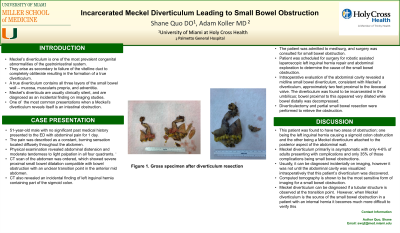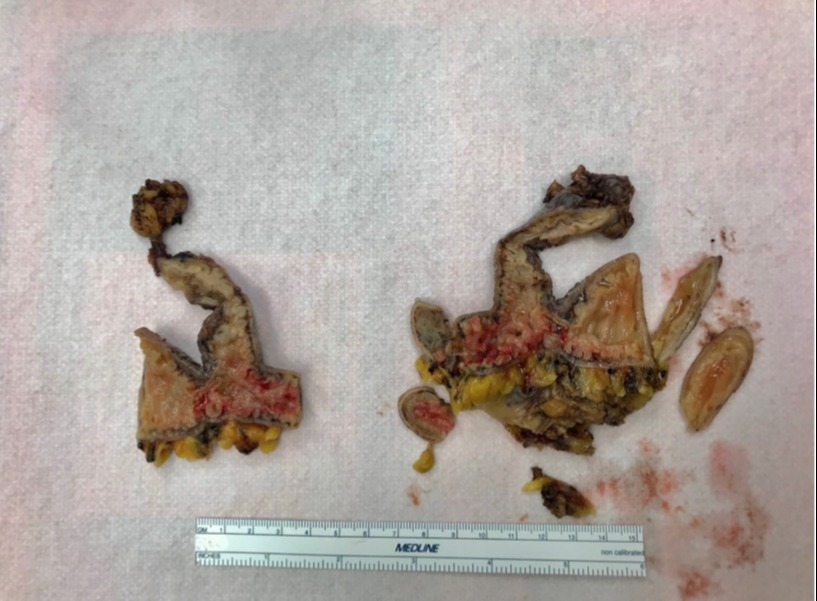Tuesday Poster Session
Category: Small Intestine
P4122 - Incarcerated Meckel's Diverticulum Leading to Small Bowel Obstruction
Tuesday, October 24, 2023
10:30 AM - 4:00 PM PT
Location: Exhibit Hall

Has Audio

Shane Quo, DO
University of Miami at Holy Cross Hospital
Fort Lauderdale, FL
Presenting Author(s)
Shane Quo, DO1, Adam Koller, DO2
1University of Miami at Holy Cross Hospital, Fort Lauderdale, FL; 2Palmetto General Hospital, Miami, FL
Introduction: Meckel's diverticulum is one of the most prevalent congenital abnormalities of the gastrointestinal system. They arise secondary to the failure of the vitelline duct to obliterate, resulting in the formation of a true diverticulum. A true diverticulum contains all three layers of the small bowel wall -- mucosa, muscularis propria, and adventitia. Meckel's diverticula are usually clinically silent and are diagnosed as an incidental finding on imaging studies. However, intestinal obstruction is one of the most common presentations when a Meckel's diverticulum reveals itself.
Case Description/Methods: A 51-year-old male with no past medical history presented to the emergency room with abdominal pain for one day. The pain was described as a burning sensation located diffusely throughout the abdomen. Examination revealed abdominal distention and moderate tenderness to palpation. CT Abdomen revealed severe proximal small bowel dilatation compatible with bowel obstruction with an unclear transition point in the anterior mid-abdomen. CT also revealed an incidental finding of a left inguinal hernia containing part of the sigmoid colon. Surgery was consulted for small bowel obstruction. The patient was scheduled for surgery for a left inguinal hernia repair and abdominal exploration to determine the cause of the small bowel obstruction. Intraoperative evaluation of the abdominal cavity revealed a midline small bowel diverticulum, consistent with Meckel's diverticulum, approximately two feet proximal to the ileocecal valve. The diverticulum was found to be incarcerated within the umbilicus; the bowel proximal to this appeared very dilated while the bowel distally was decompressed. Diverticulectomy and partial small bowel resection were performed to relieve the obstruction.
Discussion: This patient was found to have two areas of blockage: the left inguinal hernia causing a sigmoid colon obstruction, and the Meckel diverticulum attached to the posterior aspect of the abdominal wall. Although it can be diagnosed incidentally, it was not until the abdominal cavity was visualized that this patient's diverticulum was discovered. Meckel’s diverticulum can be diagnosed if a tubular structure is observed at the transition point. However, when Meckel's diverticulum is the source of the small bowel obstruction in a patient with an internal hernia, it becomes much more challenging to verify this. Thus, it is important to keep Meckel's diverticulum in mind when diagnosing a patient with small bowel obstruction.

Disclosures:
Shane Quo, DO1, Adam Koller, DO2. P4122 - Incarcerated Meckel's Diverticulum Leading to Small Bowel Obstruction, ACG 2023 Annual Scientific Meeting Abstracts. Vancouver, BC, Canada: American College of Gastroenterology.
1University of Miami at Holy Cross Hospital, Fort Lauderdale, FL; 2Palmetto General Hospital, Miami, FL
Introduction: Meckel's diverticulum is one of the most prevalent congenital abnormalities of the gastrointestinal system. They arise secondary to the failure of the vitelline duct to obliterate, resulting in the formation of a true diverticulum. A true diverticulum contains all three layers of the small bowel wall -- mucosa, muscularis propria, and adventitia. Meckel's diverticula are usually clinically silent and are diagnosed as an incidental finding on imaging studies. However, intestinal obstruction is one of the most common presentations when a Meckel's diverticulum reveals itself.
Case Description/Methods: A 51-year-old male with no past medical history presented to the emergency room with abdominal pain for one day. The pain was described as a burning sensation located diffusely throughout the abdomen. Examination revealed abdominal distention and moderate tenderness to palpation. CT Abdomen revealed severe proximal small bowel dilatation compatible with bowel obstruction with an unclear transition point in the anterior mid-abdomen. CT also revealed an incidental finding of a left inguinal hernia containing part of the sigmoid colon. Surgery was consulted for small bowel obstruction. The patient was scheduled for surgery for a left inguinal hernia repair and abdominal exploration to determine the cause of the small bowel obstruction. Intraoperative evaluation of the abdominal cavity revealed a midline small bowel diverticulum, consistent with Meckel's diverticulum, approximately two feet proximal to the ileocecal valve. The diverticulum was found to be incarcerated within the umbilicus; the bowel proximal to this appeared very dilated while the bowel distally was decompressed. Diverticulectomy and partial small bowel resection were performed to relieve the obstruction.
Discussion: This patient was found to have two areas of blockage: the left inguinal hernia causing a sigmoid colon obstruction, and the Meckel diverticulum attached to the posterior aspect of the abdominal wall. Although it can be diagnosed incidentally, it was not until the abdominal cavity was visualized that this patient's diverticulum was discovered. Meckel’s diverticulum can be diagnosed if a tubular structure is observed at the transition point. However, when Meckel's diverticulum is the source of the small bowel obstruction in a patient with an internal hernia, it becomes much more challenging to verify this. Thus, it is important to keep Meckel's diverticulum in mind when diagnosing a patient with small bowel obstruction.

Figure: Figure 1. Gross pathology removed during operation
Disclosures:
Shane Quo indicated no relevant financial relationships.
Adam Koller indicated no relevant financial relationships.
Shane Quo, DO1, Adam Koller, DO2. P4122 - Incarcerated Meckel's Diverticulum Leading to Small Bowel Obstruction, ACG 2023 Annual Scientific Meeting Abstracts. Vancouver, BC, Canada: American College of Gastroenterology.
